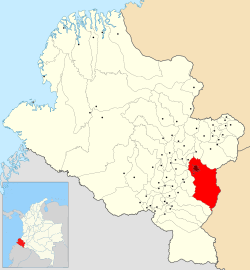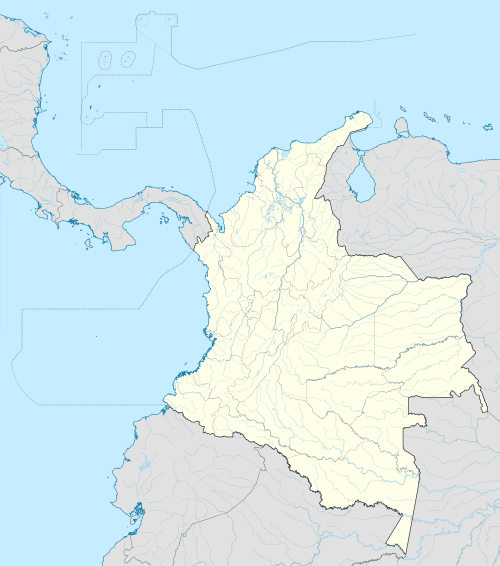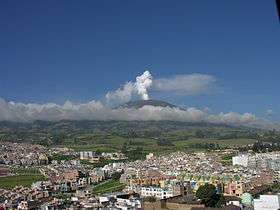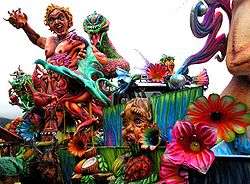Pasto, Colombia
| San Juan de Pasto | |||
|---|---|---|---|
| City | |||
| San Juan de Pasto | |||
 | |||
| |||
|
Nickname(s): Ciudad Sorpresa (Surprise City) Ciudad Teológica (Theological City) Tierra del Galeras (Galeras's Land) | |||
| Motto: "Muy Noble Y Muy Leal Ciudad de San Juan de Pasto" ("Very Noble and Very Loyal City of San Juan de Pasto) | |||
 Location of the municipality and city of Pasto in the Department of Nariño | |||
 San Juan de Pasto Location in Colombia | |||
| Coordinates: 01°12′28″N 77°16′38″W / 1.20778°N 77.27722°WCoordinates: 01°12′28″N 77°16′38″W / 1.20778°N 77.27722°W | |||
| Country |
| ||
| Region | Pacific Region/Andes Region | ||
| Department | Nariño | ||
| Founding | 1537 | ||
| Established | June 24, 1539 (Atriz Valley) | ||
| Founded by | Sebastián de Belalcázar | ||
| Named for | Saint John the Baptist | ||
| Government | |||
| • Type | Municipality | ||
| • Mayor | Harold Guerrero López | ||
| Area | |||
| • City | 1,181 km2 (456 sq mi) | ||
| • Urban | 26.4 km2 (10.2 sq mi) | ||
| Elevation | 2,527 m (8,291 ft) | ||
| Population (2007) | |||
| • City | 480,000 | ||
| • Density | 410/km2 (1,100/sq mi) | ||
| Demonym(s) | Pastuso | ||
| Time zone | Eastern Time Zone (UTC-05) | ||
| Postal code | 520001-520099 | ||
| Area code(s) | 57 + 2 | ||
| Website | Official website (Spanish) | ||
Pasto (Colombia), officially San Juan de Pasto, is the capital of the department of Nariño, located in southern Colombia. The city is located in the "Atriz Valley", on the Andes cordillera, at the foot of the Galeras volcano, at an altitude of 8,290 feet (2,527 m) above sea level. The city has a population of approximately 500,000 inhabitants.
History
Pasto was founded in 1537 by the Spanish conquistador Sebastián de Belalcázar. In 1539 another Spanish conquistador Lorenzo de Aldana moved the city to its current location, and established it under the name "San Juan de Pasto". Pasto is a reference to the name of the indigenous people who inhabited the region at the arrival of the conquerors, the Pastos. However, the Atriz Valley was inhabited by the Quillacingas. A major contributor to the economy and expansion of Pasto was a man of Italian origin named Guido Bucheli.
It has been an administrative, cultural and religious center of the region since colonial times. Because of this, the city is known as the theological city of Colombia. During the Independence Wars against Spain Pasto was a royalist city, unlike the rest of the country. Partly due to this political stance, and because of its geographical location, after independence Pasto remained isolated for a long time from the rest of the Colombia.
Geography

Climate
Under the Köppen climate classification, Pasto features a subtropical highland climate with relatively consistent temperatures throughout the course of the year. Despite the fact that the city is located close to the equator, due to its high altitude, Pasto average high temperatures typically ranges only between 15°C and 18°C while average low temperatures are usually between 9°C and 11°C. Pasto averages roughly 800 mm of precipitation annually.
| Climate data for Pasto, Colombia (Obonuco) 1981–2010 | |||||||||||||
|---|---|---|---|---|---|---|---|---|---|---|---|---|---|
| Month | Jan | Feb | Mar | Apr | May | Jun | Jul | Aug | Sep | Oct | Nov | Dec | Year |
| Record high °C (°F) | 25.2 (77.4) |
24.7 (76.5) |
22.0 (71.6) |
23.1 (73.6) |
22.3 (72.1) |
23.1 (73.6) |
21.7 (71.1) |
23.0 (73.4) |
23.0 (73.4) |
24.0 (75.2) |
23.2 (73.8) |
23.1 (73.6) |
25.2 (77.4) |
| Average high °C (°F) | 17.0 (62.6) |
17.2 (63) |
17.3 (63.1) |
17.5 (63.5) |
17.4 (63.3) |
16.8 (62.2) |
16.3 (61.3) |
16.7 (62.1) |
17.5 (63.5) |
17.8 (64) |
17.4 (63.3) |
17.3 (63.1) |
17.2 (63) |
| Daily mean °C (°F) | 12.9 (55.2) |
13.1 (55.6) |
13.1 (55.6) |
13.3 (55.9) |
13.3 (55.9) |
12.9 (55.2) |
12.4 (54.3) |
12.5 (54.5) |
12.9 (55.2) |
13.0 (55.4) |
12.9 (55.2) |
12.9 (55.2) |
12.9 (55.2) |
| Average low °C (°F) | 9.5 (49.1) |
9.6 (49.3) |
9.7 (49.5) |
10.0 (50) |
10.1 (50.2) |
10.0 (50) |
9.4 (48.9) |
9.4 (48.9) |
9.3 (48.7) |
9.4 (48.9) |
9.6 (49.3) |
9.6 (49.3) |
9.6 (49.3) |
| Record low °C (°F) | 3.5 (38.3) |
1.0 (33.8) |
1.3 (34.3) |
1.2 (34.2) |
4.5 (40.1) |
3.4 (38.1) |
3.0 (37.4) |
3.8 (38.8) |
3.6 (38.5) |
1.0 (33.8) |
4.4 (39.9) |
0.0 (32) |
0.0 (32) |
| Average precipitation mm (inches) | 69.1 (2.72) |
65.7 (2.587) |
81.1 (3.193) |
87.1 (3.429) |
77.6 (3.055) |
44.7 (1.76) |
32.8 (1.291) |
25.0 (0.984) |
63.9 (2.516) |
95.5 (3.76) |
101.1 (3.98) |
82.9 (3.264) |
826.4 (32.535) |
| Average precipitation days | 17 | 16 | 19 | 20 | 20 | 17 | 15 | 14 | 14 | 17 | 19 | 20 | 206 |
| Average relative humidity (%) | 82 | 81 | 83 | 82 | 81 | 79 | 77 | 74 | 75 | 79 | 83 | 83 | 80 |
| Mean monthly sunshine hours | 111.6 | 87.6 | 83.7 | 84.0 | 93.0 | 102.0 | 111.6 | 111.6 | 99.0 | 102.3 | 105.0 | 108.5 | 1,199.9 |
| Mean daily sunshine hours | 3.6 | 3.1 | 2.7 | 2.8 | 3.0 | 3.4 | 3.6 | 3.6 | 3.3 | 3.3 | 3.5 | 3.5 | 3.3 |
| Source: Instituto de Hidrologia Meteorologia y Estudios Ambientales[1][2][3] | |||||||||||||
Economy
In the municipality 11.1% of establishments are dedicated to industry; 56.0% to trade; 28.9% to services and 4.1% to other activities.
In urban areas, the main economic activities are trade and service industries with some small businesses, of which about 50% are craft manufacturing. The larger companies in Nariño are located in Pasto, and are largely involved with food, beverages and furniture production. For the development of trade, mainly with the neighboring country of Ecuador, there are several shopping centers. The Pasto Chamber of Commerce was established in 1918 and according to the 2008 yearbook had 14,066 commercial establishments of which 58.5% were engaged in trade and repair of vehicles. In the rural areas there is predominantly farming and cattle ranching, in addition there is a small-scale mining industry.[4]
Infrastructure
Water and sanitation
By means of the Pasto Sanitation Company the urban area has a 93% provision of water and sanitation. In the rural area 74% have mains water and 33% have plumbed sanitation.
Land access
Pasto is connected northwards by land with Popayán and south, 78 km away with Ipiales on the border with the Republic of Ecuador by the Pan-American Highway. The distance from Pasto to the capital of the republic, Bogotá, on the Panamerican Highway is 798 km with a travel time of about 18 hours. To the west the city is connected to the port of Tumaco on the Pacific coast, by a paved road of 284 km, and to the east with Mocoa in Putumayo department with a road of about 145 km. For national intercity land transport there is a terminal used by the principal transport operating companies and which is used by approximately two million passengers a year.
Air access
Antonio Narino Airport is 35 km from the city, in the nearby town of Chachagüí, it provides domestic air connections offered by Colombian airlines Avianca and Satena.
Telecommunications
Telephone and internet: Various companies like Telmex, Movistar, Claro, Tigo, Avantel, and UNE-Orbitel provide telecommunication service in Pasto by means of Mobile phones, all companies providing UMTS cover and HSDPA. Broad band internet connection and terrestrial telephones are also provided.
Radio broadcasting: Within the city there are various FM radio broadcasting companies such as Radio University of Nariño, National Police Radio, community radio and commercial radio stations with a high musical content. There are also some AM stations available of which the oldest is Radio Nariño (founded in 1937) and Radio Pasto Echos, (1941).
Television: In Pasto there is full access to all the national TV stations such as Channel 1 (Canal Uno), Station Institutional, (Señal Institucional) and Station Columbia (Señal Colombia). In addition there are regional programmes like Telepacífico and TelePasto. There are also local private stations like Nariño TV, TV Telmex and CNC Global TV. and national private stations such as RCN Televisión y Caracol Televisión, and finally there are subscription stations through companies like Telmex, Movistar, Global TV and DirecTV.
Health
The majority of the institutions that make up the health network of Nariño department are located in Pasto. These comprise 6 hospitals and 4 clinics for levels of attention 2 and 3. For levels of attention 1 there are 7 health centres and 2 health stations. In total these provide 1332 hospital beds to meet the demand of internal medicine, surgery, paediatrics, obstetrics and a basic psychiatric service.
In the city the public institutions are organized into four networks for the delivery of their services. The northern network is coordinated by the Civil Hospital including three health posts and a center. The southern network, coordinated by the Health Center of the Rose includes three health posts, a center and a mobile unit. The southeastern network, coordinated by the Lorenzo de Aldana Health Center includes five health posts and a center. The west network coordinated by the Tamsagra Health Center includes five health centers and the Center for Zoonoses.[5]
The main hospitals are:
- University Hospital Department of Nariño HUDN.
- Clinic Our Lady of Fatima
- St. Peter's Hospital Foundation
- Children's Hospital Los Angeles
- Our Lady of Perpetual Help Mental Hospital(women's mental health)
- San Rafael de Pasto Hospital(male mental health)
- Civil Hospital
Education
There are several universities with students from Pasto and from other cities in Nariño, some of them are:
- University of Nariño
- Universidad Mariana
- Universidad Cooperativa de Colombia
- Fundación Universitaria San Martin
- Institución Universitaria Cesmag
- Universidad Antonio Nariño
- Universidad Nacional Abierta y a Distancia - UNAD
- Escuela Superior de Administración Pública - ESAP
- Corporación Universitaria Autónoma de Nariño
Carnival and arts
One of the most important events held by the city is the Blacks and Whites' Carnival (Carnaval de Negros y Blancos in Spanish), with outstanding displays of craftmanship in floats portraying legends and traditions, often mixed in with references to current political events in Colombia. During the carnival the city goes wild and unleashes all the joy it has bottled up all year. It is not advisable to wear nice clothes during this festival, as during these celebrations people have fun painting each other's faces with cosmetics colors (skin safe and created for this special purpose) and throwing talcum powder and party foam. The carnival takes place between January 2nd and 7th each year.
A speciality of this region is a pre-Columbian art technique called Barniz de Pasto, or Pasto Varnish in English. This uses a type of natural rubber (extracted from a tree called mopa-mopa) which is colored and then stretched over woodwork pieces; finally the skillful artisan uses a special knife to cut and create the many beautiful designs that characterise this artistic technique.
Tourism
The main attraction in the town of Pasto is Lake Guamuez or La Cocha lake, located 27 kilometers from the city, 45 minutes by road, and 2800 meters over the sea level. On the site you can enjoy the scenery, food (especially rainbow trout), fishing and boating. In the middle of the lake there is the Island of La Corota, a National Forest Sanctuary.
For lovers of cultural tourism, in addition to its museums mentioned above, the city offers visitors a wealth of churches among which stands out the Church of San Juan Bautista of the eighteenth century, the cathedral, the Church of Our Lady of Mercy, the Church of San Felipe, the Church of San Sebastián or "the Bakery", Temple of Christ the King, St. James, and the Church of St. Augustine.
For ecotourism, the Chimayoy Environmental Center, meaning in Quillacinga "go to meet with the sun." Located 4 km on the road between San Juan de Pasto in Colombia's interior is a space provided for education, tourism and research environmental and ecological conservation, has long nature trails and diverse activities that seek methodologically integration of individuals and the community with the environment, promoting and strengthening ecological projects.
Gastronomy
The dishes that most represent the gastronomy of Pasto are the products of mixed cultures, the expression of the lands fertility and the hard work of the people. The most typical is grilled or roasted guinea pig (locally called 'cuy'). On 7th January they celebrate the festival of the guinea pig in the nearby village of Catambuco as the culmination of the "Blacks and Whites Carnival". Among the typical outstanding desserts are "bucket ice-cream", made in a copper bucket cooled with crushed ice, a dessert made with mountain papayas, (called 'chilacuán' locally), dough-based pastries of which 'quimbolitos' and filled pasties (empanadas de añejo) are the best known.
Some of the typical drinks are made of heated juice of, for example, lulo, mora (similar to blackberries) and passion fruit. These make the base of a drink that may be strengthened by a local liquor called chapil or aguardiente.
Sports

In San Juan de Pasto has developed extensive sports culture, both recreational and competitive. The football is one of the main sports practiced in the city since November 1909 when Spain Leslie Osmond, a British citizen who was visiting the area for commercial purposes, organizes a football match in a makeshift court in the District of San Andrew, and three months of their stay in the city formed the first football team.[6]
The city is home to the Deportivo Pasto, team founded in 1949, which remained outside the professionalism until 1996 when he ascended to the Primera B and two years later was promoted to the Primera A Colombian professional football. In June 2006 were crowned champions earning a spot to compete in the 2007 by the Copa Libertadores. In 2009 won the second place in the Copa Colombia, losing from the collections of the maximum penalty against Santa Fe and in the same year dropped to Category B. Subsequently regains its first place in category A in December 2011, when the Patriots beat the end of that category.
Pasto is home to many outstanding athletes, which include the marchista Luis Fernando López (medalist in the World Athletics Championships 2011), footballers Carlos Daniel Hidalgo (scorer of the World Cup U-17 of 2003), the cyclist Carlos Ramirez Campaign, Jorge Vidal, Hernán Pantoja and Miguel Cabrera, among others.
In Pasto, as in other towns of Nariño and in some regions of Ecuador, practiced a traditional sport, very old and unparalleled in other regions of Colombia called Chaza, a ball game, similar to tennis or jai alai, characterized by the use of a heavy wood and leather shoe called drums and played in teams on a rectangular court earth.
Sports stage
- The Departmental Liberty Stadium, with capacity for 27,380 spectators.
- The covered arena Sergio Antonio Ruano.
- The covered arena of Southeast Neighborhoods. (used primarily for indoor soccer, basketball and volleyball).
- Unit Pastusidad sports Third Millennium, with skating rink, tennis and cycling BMX located on the road to the village of Obonuco.
- The Grass Tennis Club with 6 clay courts
- The Club Colombia with 6 tennis tennis of clay
- The Club Trade with 2 tennis tennis of clay
References
- ↑ "Promedios Climatológicos 1981–2010" (in Spanish). Instituto de Hidrologia Meteorologia y Estudios Ambientales. Archived from the original on 14 August 2016. Retrieved 16 August 2016.
- ↑ "Promedios Climatológicos 1971–2000" (in Spanish). Instituto de Hidrologia Meteorologia y Estudios Ambientales. Archived from the original on 14 August 2016. Retrieved 16 August 2016.
- ↑ "Tiempo y Clima" (in Spanish). Instituto de Hidrologia Meteorologia y Estudios Ambientales. Archived from the original on 14 August 2016. Retrieved 16 August 2016.
- ↑ Publicaciones de la Cámara de Comercio de Pasto
- ↑ Plan de desarrollo municipal. 2004 – 2007
- ↑ Munoz, Lydia Agnes. History of Pasto Manual, Volume 7. Manual Pasto history. Editor Nariñense Academy of History, 1996. ISBN 958-33-3584-3, 9789583335846
External links
 Pasto travel guide from Wikivoyage
Pasto travel guide from Wikivoyage- Photos of the "Carnaval de Blancos y Negros"
- Universidad de Nariño
- Photos Carnaval de Negros Y Blancos Pasto
- Mayor's office
- Pasto Volcanological and Seismological Observatory - INGEOMINAS
- Sobre el barniz de Pasto
- Pasto Weather



